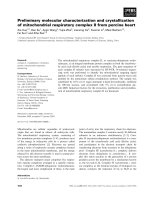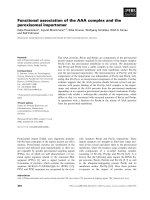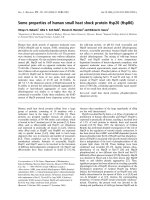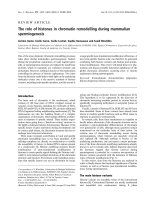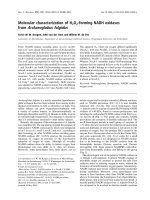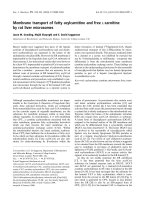Báo cáo khoa học: "Preliminary results of common oak (Quercus robur L) provenance experiments" pot
Bạn đang xem bản rút gọn của tài liệu. Xem và tải ngay bản đầy đủ của tài liệu tại đây (343.94 KB, 7 trang )
Original
article
Preliminary
results
of
common
oak
(Quercus
robur
L)
provenance
experiments
in
Croatia
J
Gracan
Forest
Research
Institute,
Jastrebarsko,
Cvijethno
Naslje
41, 41420 Jastrebarsko,
Croatia
Summary —
The
first
experiment
with
16
provenances
of
Quercus
robur
L from
Croatia
was
estab-
lished
in
the
nursery
of
the
Forest
Research
Institute
in
Jastrebarsko
in
the
spring
of
1986.
Field
ex-
periments
with
4
randomized
blocks
in
2
localities
were
laid
out
in
1988.
After
5
years
(1990),
the
Spacva provenance
performed
best
in
terms
of
height
growth.
Survival
varied
from
34.0%
(Moto-
vunska
Suma
at
Slavir)
to
98.5%
(Gunja
at
Gajno).
provenance
/
Quercus
robur /
height
growth
/
survival
/ Croatia
Résumé —
Résultats
préliminaires
de
plantations
comparatives
de
provenances
de
chêne
pé-
donculé
(Quercus
robur
L)
en
Croatie.
La
première
comparaison
de
provenances
de
Quercus
robur L
de
Croatie
a
été
mise
en
place
dans
la
pépinière
de
l’Institut
de
recherches
forestières
de
Jastrebarsko
au
printemps
1986.
Elle
comprend
16
provenances.
Les
tests
en
forêt
ont
été
installés
dans
2
stations;
chacune
comprend
4
blocs
randomisés. À
l’issue
de
la
cinquième
année
de
végéta-
tion,
la
provenance
Spacva
s’est
avérée
la
plus
vigoureuse
(croissance
en
hauteur).
Les
taux
de
sur-
vie
varient
de
34%
(provenance
Motovunska
Šuma
dans
la
station
Slavir)
à
98,5%
(provenance
Gunja
dans
la
station
Gajno).
provenance
/ Quercus
robur
/ croissance
en
hauteur / surviel
/ Croatie
INTRODUCTION
Common
oak
(Quercus
robur
L)
is
one
of
the
most
valuable
and
the
most
important
forest
trees
in
Croatia.
The
value
and
quality
of
the
wood
of
the
famous
"Slavoni-
an
oak"
is
well
known
in
Croatia
and
in
world
markets.
However,
difficulties
with
natural
regeneration
and
forest
decline
re-
quire
more
extensive
production
of
oak
seedlings
from
forest
nurseries
(Dokuš
and
Komlenovi&jadnr;,
1979;
Androi&jadnr;,
1987;
Prpi&jadnr;,
1987).
Considering
these
facts,
proper
provenance
sources
are
very
im-
portant
(Komlenovi&jadnr;
et
al,
1988).
The
main
natural
range
of
Quercus
robur
in
Croatia
is
along
the
Sava
river
(45°
lati-
tude),
about
400
km
long.
The
total
wood-
land
area
of
Quercus
robur
in
Croatia
is
170
000
ha
containing
40
million
m3
of
sol-
id
wood
(Kova&jadnr;i&jadnr;,
1990).
Oak
provenance
research
was
started
in
1985-1986.
The
purpose
was
to
study
variability
and
wood
productivity
of
differ-
ent
provenances
in
Croatia.
It
is
very
im-
portant
for
forestry
practice
to
determine
which
oak
provenances
are
productive
and
most
suitable
for
different
forest
re-
gions
(Gra&jadnr;an,
1986).
MATERIALS
AND
METHODS
The
collection
of
seed
was
started
in
the
au-
tumn
of
1985.
Samples
of
150-200
kg/
provenance
were
collected.
Eleven
provenances
from
Croatia
and
1
from
Serbia
were
included
in
the
nursery
phase
of
the
experiment.
The
field
experiment
also
includes
seedlings
from
4
com-
mercial
provenances.
These
were
grown
in
commercial
nurseries
and
were
used
as
con-
trols.
The
general
information
about
the
prove-
nances
(latitude,
longitude,
elevation,
and
soil)
is
given
in
table
I.
Seed
from
12
provenances
was
sown
in
the
nursery
of
the
Forest
Research
Institute
at
Jas-
trebarsko
in
the
spring
of
1986.
The
experiment
was
laid
out
in
a
randomized
block
design
with
4
blocks,
using
20-25
kg
of
acorns
from
each
provenance/block.
The
seedlings
were
grown
in
the
nursery
for
2
years
until
the
autumn
of
1987.
Heights
were
measured
in
the
autumns
of
1986
and
1987.
Survival
was
assessed
in
the
autumn
of
1987.
Field
experiments
of
16
oak
provenances
were
laid
out
at
2
different
localities
in
the
au-
tumn
of
1987
and
in
the
spring
of
1988.
The
ex-
periments
were
established
in
complete
random-
ized
block
designs
each
with
4
replications,
with
100
oak
seedlings/provenance/replication.
Spac-
ings
were
1.5
x
1.5
m.
In
total,
12 800
oak
seed-
lings
were
planted,
ie
6
400
per
locality
(16
x
100
x
4).
The
experiments
are
located
at
Slavir
and
Gajno
(fig
1).
Heights
and
survival
were
recorded
at
both
sites
in
the
autumns
of
1988,
1989
and
1990.
All
data
were
submitted
to
analyses
of
variance
(Steel
and
Torrie,
1960)
at
the
computing
center
of
Zagreb.
RESULTS
AND
DISCUSSION
Summaries
of
heights
and
survival
of
seed-
lings
in
the
nursery
during
1986
and
1987
are
given
in
table
II.
It
is
evident,
that
prove-
nances
10
Spa&jadnr;va
(35.6
cm),
12
Morovi&jadnr;
(35.7
cm),
9
Guševac
(35.6
cm)
and
8
Dur-
denovac
(35.5
cm)
achieved
the
best
aver-
age
heights
at
2
years
of
age.
Average
sur-
vival
of
all
seedlings
in
the
nursery
phase
in
the
autumn
of
1987
was
86.5%,
and
it
var-
ied
from
69.3%
for
provenance
8
Durdeno-
vac
to
96.4%
for
provenance
5
Novska.
In
a
fertilizing
experiment
(Komlenovic
et
al,
1988)
with
4
oak
species
and
6
prov-
enances
of
Quercus
robur
(Motovun,
Orlo-
vac,
Novska,
Durdenovac,
Spa&jadnr;va
and
Morovic),
provenances
Spa&jadnr;va
(22.6
cm)
and
Morovi&jadnr;
(22.3
cm)
had
the
greatest
heights.
These
seedlings
had
been
raised
in
paper
pots
on
3
different
substrata.
In
5
out
of
the
6
provenances
there
was
no
frost
damage.
Only
the
Motovun
prove-
nance
lost
23%
of
the
total
number
of
seedlings.
These
data
are
very
important
for
the
choice
of
suitable
provenances
for
reforestation.
From
the
results
of
these
nursery
experiments
and
the
fertilizing
ex-
periment,
it
is
evident
that
provenances
10
(Spa&jadnr;va)
and
12
(Morovi&jadnr;)
are
among
the
best
at
1
and
2
years
of
age.
The
quality
of
nutrition
is
of
great
importance
for
oak
seedling
production
in
forest
nurseries,
but
the
proper
provenance
choice
is
even
more.
Little
research
has
been
done
on
fertilization
of
oak
provenances
(Ani&jadnr;,
1963;
Dekani&jadnr;,
1971;
D&jadnr;ekova,
1976;
Komienovi&jadnr;,
1981;
Komlenovi&jadnr;
and
Ras-
tovski,
1982;
Komlenovi&jadnr;
and
Cestar,
1984;
Komlenovi&jadnr;
et al,
1988).
Summaries
of
average
heights
and
sur-
vival
in
the
field
experiments
Gajno
and
Slavir
are
given
in
table
III
and
figure
2.
Ta-
ble
III
gives
the
average
heights
and
survi-
val
in
the
autumns
of
1988,
1989
and
1990.
The
F-test
values
from
analyses
of
variance
are
also
presented.
From
table
III
it
is
evident
that
prove-
nance
10
(Spa&jadnr;va)
had
the
greatest
aver-
age
height
at
Slavir
(37.1
cm)
but
at
this
provenance
Gajno
was
in
second
place
in
1988
with
a
height
of
39.5
cm.
At
Gajno
the
tallest
provenance
in
1988
was
16
(Vrbanja
(42.3
cm),
but
at
Slavir
with
a
height
of
31.7
cm
it
was
10th.
The
lowest
average
height
at
Gajno
was
for
prove-
nance
9
(Guševac)
(31.2
cm)
and
at
Slavir
provenance
14
(Zdena&jadnr;ki
Gaj)
(26.7
cm).
The
average
height
of
all
16
provenances
was
36.1
cm
at
Gajno
and
32.6
cm
at
Slá-
vir.
Average
survival
in
the
autumn
of
1988
was
relatively
high:
97.9%
at
Gajno
rang-
ing
from
96.0
to
99.7%,
and
90.2%
at
Sla-
vir
ranging
from
86.0
to
98.5%.
There
were no
significant
differences
between
provenances.
From
table
III
it
is
evident
that
prove-
nance
10
(Spa&jadnr;va)
was
tallest
in
1989
at
both
Gajno
(58.7
cm)
and
Slavir
(39.9
cm)
but
in
1990,
as
shown
in
table
III
and
fig-
ure
1
it
fell
to
3rd
place
at
both
locations
with
heights
of
72.5
cm
(Gajno)
and
40.8
cm
(Slavir).
The
greatest
average
height
in
1990
at
Gajno
was
exhibited
by
prove-
nance
7
(Oku&jadnr;ani)
(74.4
cm)
and
at
Slavir
by
provenance
14
(Klju&jadnr;evi)
(42.4
cm).
The
average
height
of
all
16
provenances
at
Gajno
in
1989
was
51.8
cm,
while
at
Slavir
it
was
36.7
cm.
In
the
autumn
of
1990,
these
averages
were
65.7
and
38.7 cm,
respectively.
The
smallest
aver-
age
height
in
the
autumn
of
1990
at
Gajno
(52.2
cm)
and
Slavir
(35.1
cm)
was
in
prov-
enance
13
(Dubica).
Average
survival
in
1989
and
1990
was
higher
at
Gajno
(96.2
and
95.8%)
than
at
Slavir
(74.6
and
36.7%).
The
seedlings
of
all
16
provenances
at
Slavir
had
been
heavily
attacked
by
mice.
From
table
III
it
is
evident
that
there
were
few
significant
differences
between
provenance
means
for
heights
and
none
for
survival.
CONCLUSION
The
first
results
from
the
experiment
with
16
Quercus
robur
L
provenances
at
Gajno
and
at
Slavir
have
shown
that
Spacva
is
better
than
the
other
15.
Be-
cause
these
oak
provenance
experiments
are
very
young
(5
yr)
it
is
necessary
to
be
cautious
in
interpreting
the
results
and
to
continue
with
these
investigations.
ACKNOWLEDGMENTS
The
study
was
supported
by
Croatian
Forestry
Enterprise
Hrvatske
sume
and
the
Croatian
Sci-
entific
Fund.
REFERENCES
Androi&jadnr;
M
(1987)
Sušenje
hrasta.
Sušenje
šuma.
Sumarska
Endiklopedija
(Zagreb)
3,
314-315
Ani&jadnr;
M
(1963)
Utjecaj
stajskog
gnoja
na
razvitak
kultura
hrasta
lu&jadnr;njaka.
Šumarski
List 7-8,
1 -
16
Dekani&jadnr;
I
(1971)
Intenziviranje
proizvodnje
drva
u
cenozi
hrasta
kitnjaka
i
obicnog
graba
(Querceto-carpinetum
Croaticum
Horv)
prim-
jenom
proreda
i fertilizacije
razlicitim
mineral-
nim gnojivima.
Sumarski List 7-8,
197-230
D&jadnr;ekova
M
(1976)
Promena
sastava
lisca
kukve
i
hrasta
kitnjaka
tokom
vegetacijske
sezone
i
u
zavisnosti
od
ekoloških
uslova.
Zmljište
Bilj-
ke
25,
225-232
Dokuš
A,
Komlenovi&jadnr;
N
(1979)
Stanje
rasad-
nicke
proizvodnje
u
SR
Hrvatskoj.
Šumarski
Inst Jastrebarsko 1-23
Gra&jadnr;an
J
(1986)
Program
Znanstvenoistra&jadnr;i-
Va&jadnr;kog
Rada
za
Razbodlje
1986
do
1990
Godine.
Poslovna
zajednica
"Exportdrvo",
Zagreb,
1986
Komlenovi&jadnr;
N
(1981)
Sezonska
promjena
sadr-
&jadnr;aja
hraniva
u
biljkama
hrasta
luznjaka
(Quercus
robur L)
i kitnjaka
(Quercus petraea
Matt/Liebel).
An
Šumarstvo
10/2,
43-60
Komlenovi&jadnr;
N,
Cestar
D
(1984)
Istra&jadnr;ivanje
stanja
ishrane
hrasta
lu&jadnr;njaka
(Quercus
ro-
bur
L)
u
utvrdenim
ekološko-gospdarskim
ti-
povima
šuma
SR
Hrvatske.
Rad
Sumarskog
Inst
Jastrebarsko
59,
1-34
Komienovi&jadnr;
N,
Rastovski
P
(1982)
Mogu&jadnr;nost
unapredenja
proizvodnje
sadnica
hrasta
lu&jadnr;n-
jaka
(Quercus
robur
L)
kitnjaka
(Quercus
pe-
traea
Matt/Liebel)
i crnike
(Quercus
ilex
L)
primjenom
mineralnih
gnojiva.
Agronomija
5-
6, 209-217
Komlenovi&jadnr;
N,
Gra&jadnr;an
J,
Rastovski
P
(1988)
Is-
tra&jadnr;ivanje
rasta
i
ishrane
biljaka
hrasta
luzn-
jaka
(Quercus
robur L),
kitnjaka
(Quercus pe-
traea
Matt/Lieb)
medunca
(Quercus
pubescens
Willd)
i crnike
(Quercus
ilex
L).
RAD Broj 75,
33-49
Kova&jadnr;i&jadnr;
D
(1990)
Pregled
površina
hrasta
lu&jadnr;n-
jaka
u
Hrvatskoj.
Samoupravna
interesna
za-
jednica
šumarstva
Hrvatske-Banka
podataka
Prpi&jadnr;
B
(1987)
Ekološka
i sumsko-uzgojna
pro-
blematika
šuma
hrasta
lu&jadnr;njaka
u
Jugoslaviji.
Šumarski
List
1-2,
41-52
Steel
RGD,
Torrie
JH
(1960)
Principles
and
Pro-
cedures
of Statistics.
Mc
Graw-Hill,
New
York

